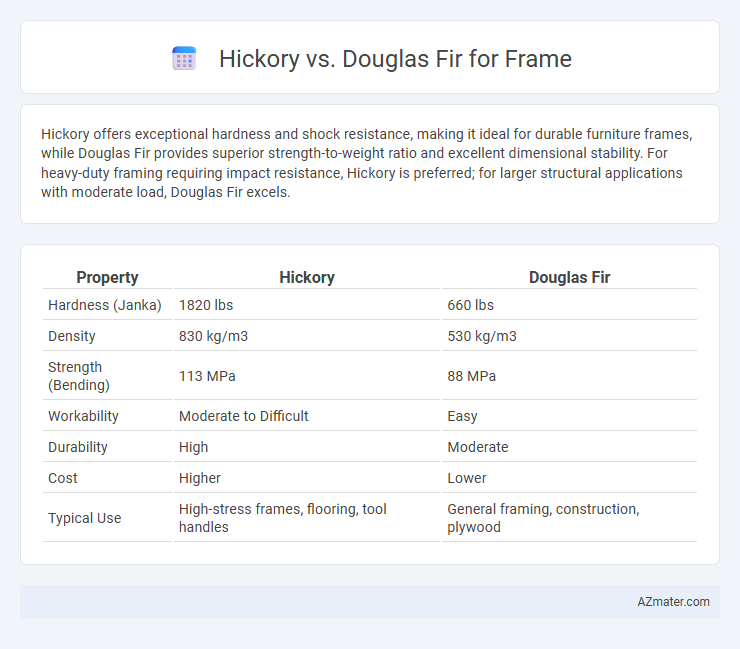Hickory offers exceptional hardness and shock resistance, making it ideal for durable furniture frames, while Douglas Fir provides superior strength-to-weight ratio and excellent dimensional stability. For heavy-duty framing requiring impact resistance, Hickory is preferred; for larger structural applications with moderate load, Douglas Fir excels.
Table of Comparison
| Property | Hickory | Douglas Fir |
|---|---|---|
| Hardness (Janka) | 1820 lbs | 660 lbs |
| Density | 830 kg/m3 | 530 kg/m3 |
| Strength (Bending) | 113 MPa | 88 MPa |
| Workability | Moderate to Difficult | Easy |
| Durability | High | Moderate |
| Cost | Higher | Lower |
| Typical Use | High-stress frames, flooring, tool handles | General framing, construction, plywood |
Introduction to Hickory and Douglas Fir
Hickory is a dense, hardwood known for its exceptional strength, shock resistance, and durability, making it ideal for heavy-duty framing applications. Douglas Fir is a softwood prized for its straight grain, stability, and high tensile strength, commonly used in construction framing due to its balance of strength and workability. Both woods provide reliable structural support, with Hickory offering superior hardness and Douglas Fir favored for its consistency and ease of use in framing projects.
Overview of Wood Characteristics
Hickory wood is renowned for its exceptional hardness, density, and shock resistance, making it ideal for heavy-duty frame construction where durability is essential. Douglas Fir offers a balanced combination of strength and flexibility, with a straight grain and moderate hardness that ensures good structural integrity and ease of workability. Both woods exhibit excellent dimensional stability, but Hickory's superior wear resistance contrasts with Douglas Fir's lighter weight and resistance to decay, influencing their suitability for specific framing applications.
Strength and Durability Comparison
Hickory offers exceptional strength and shock resistance, making it highly durable for heavy-duty framing applications, with a Janka hardness rating of 1,820 psi. Douglas Fir provides excellent structural stability and durability, widely favored in construction due to its high strength-to-weight ratio and a Janka hardness of about 660 psi. Choosing between Hickory and Douglas Fir depends on the specific framing requirements, where Hickory excels in impact resistance and Douglas Fir is preferred for overall structural integrity and ease of use.
Workability and Machining
Hickory offers exceptional workability with its high density and toughness, allowing for smooth machining and durability in frame construction. Douglas Fir, while less dense, provides superior stability and ease of cutting, making it suitable for intricate joinery and consistent machining results. Both woods perform well in frame applications, but Hickory's hardness may require sharper tools and more effort during machining compared to the more forgiving Douglas Fir.
Appearance and Grain Patterns
Hickory features a distinctive, bold grain pattern with strong contrasts between light and dark streaks, offering a rustic, eye-catching appearance ideal for framing projects seeking a natural, textured look. Douglas Fir presents a straighter, more uniform grain with subtle color variations ranging from pale yellow to reddish-brown, providing a clean, classic aesthetic preferred for modern and traditional frames. The choice between Hickory and Douglas Fir hinges on the desired visual impact, with Hickory emphasizing dramatic grain complexity and Douglas Fir delivering consistent, refined elegance.
Cost and Availability
Hickory wood generally costs more than Douglas Fir due to its denser grain and superior hardness, making it less common for framing purposes. Douglas Fir remains widely available and popular for framing because of its affordability, strength-to-weight ratio, and consistent supply from sustainable forestry practices. Cost efficiency and easier availability make Douglas Fir the preferred choice for most construction framing projects.
Weight and Density Differences
Hickory wood has a density of approximately 830 kg/m3, making it significantly heavier and denser than Douglas Fir, which has a density around 530 kg/m3. The higher density of Hickory contributes to its superior strength and hardness, ideal for durable framing requiring high load-bearing capacity. Douglas Fir's lighter weight and lower density provide easier handling and faster installation, though it may sacrifice some structural strength compared to Hickory.
Sustainability and Environmental Impact
Hickory and Douglas Fir differ significantly in sustainability and environmental impact; Douglas Fir is generally considered more sustainable due to faster growth rates and higher availability, making it a renewable resource in managed forests. Hickory, being a slower-growing hardwood, has a larger environmental footprint because harvesting reduces old-growth forest stocks and takes longer to replenish. Using Douglas Fir for framing supports eco-friendly construction practices by promoting responsible forestry and reducing carbon emissions associated with material sourcing.
Best Uses in Framing Applications
Hickory wood offers exceptional hardness and shock resistance, making it ideal for durable framing applications requiring high strength and impact resistance, such as heavy-load-bearing structures and furniture frames. Douglas Fir is renowned for its consistent grain, dimensional stability, and excellent strength-to-weight ratio, making it the preferred choice for general construction framing, including wall studs, roof trusses, and beams. Both woods provide reliable structural support, but Hickory excels in applications demanding toughness, while Douglas Fir is optimal for large-scale construction due to its workability and availability.
Conclusion: Choosing the Right Wood for Your Frame
Hickory offers superior hardness and shock resistance, making it ideal for heavy-duty frames requiring durability and impact strength. Douglas Fir provides excellent dimensional stability and is more affordable, suited for structural frames where weight and cost-efficiency are priorities. Selecting between Hickory and Douglas Fir depends on whether the frame demands maximum toughness or budget-friendly, stable construction.

Infographic: Hickory vs Douglas Fir for Frame
 azmater.com
azmater.com